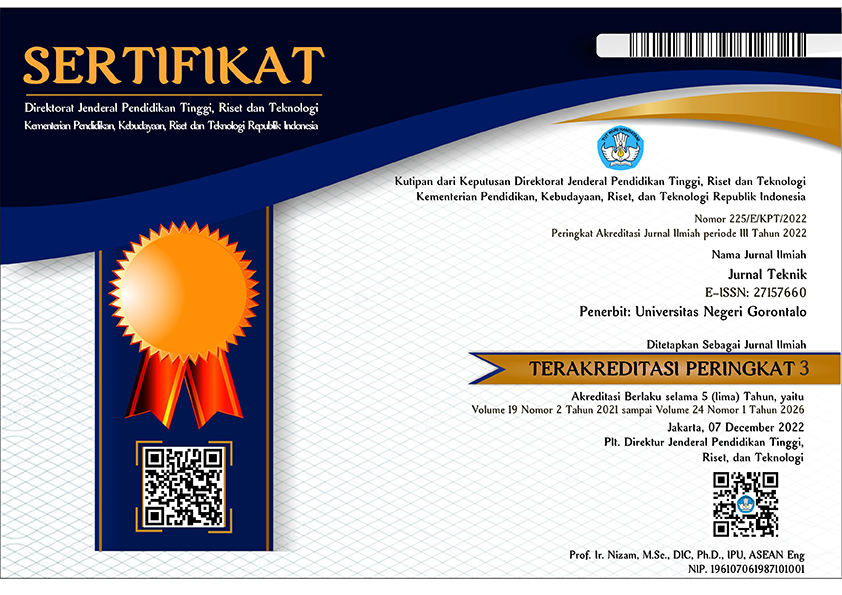Perencanaan Sumur Resapan Air Hujan dalam Upaya Konservasi Daerah Pesisir
Abstract
Infiltration wells are engineered construction designed for water conservation to accomodate and absorb surface water. Water conservation in necessary to reduce seawater intrusion in coastal areas. Shallow groundwater in Pohe village, located in a coastal a rea, is affected by seawater intrusion. This research aiams to converse groundwater in the coastal area and to reduce rainwater runoff that flows into drainage channels as well as to reduce seawater intrusion. The research is conducted in a coastal area in Pohe Village that is directly adjacent to Tomini Bay. The data are in the form of infiltration rate and soil permeability as the primary data and in form of rainfall in tensity betweet 2019 and 2020 as the secondary data. Infiltration rate data are obtained by useing a Double Ring Infiltrometer and are analyzed using the Horton method. Fourthermore, soil permeability data are tested using the constant head test. Analysis of rainfall intensity uses the Mononobe method, whereas discharge analysis employs th Rational method. The dimension of infiltration wells uses Sunjoto 1988 method.Findings reveal that the infiltration rate (ft) at the research site is 3.89 cm/hour or 38,90 mm/hour which is classified as moderate criteria. The coefficient of soil permeability (k) is 0.07 cm/second. Rain intensity (I) obtains 38.94 mm/hour. According to the data, the area of Pohe Village (A) is 4.83 km2 and the flow coefficient (C) is 0.21. The discharge analysis (Q) is 10.86 m3/second. The dimension of the infiltration wells is planned to use a cylindrical shape with a diameter of (D) 1 m and a depth of (H) 58.90 m. The are 31 wells with a depth of 1.90 m.
Downloads
References
Badan Pusat Statistik Kota Gorontalo. (2019). Kecamatan Hulontalangi Dalam Angka. Gorontalo: BPS Kota Gorontalo.
Badan Standardisasi Nasional. (2012). Tata Cara Pengukuran Laju Infiltrasi di Lapangan
Badan Pusat Statistik. (2002). Kota Gorontalo Dalam Angka. Gorontalo: Badan Pusat Statistik.
Miswardi. (2010). Penurunan Tingkat Intrusi Air Laut Berdasarkan "Chloride Bicarbonate Ratio" Menggunakan Lubang Resapan Biopori Studi Kasus di Kota Semarang. Manusia dan Lingkungan. XVII(3), pp.150-61.
Permana, A. P. (2019). Analisis Kedalaman dan KUalitas Air Tanah di Kecamatan Hulothalangi Kota Gorontalo. Ilmu Lingkungan, XVII, 15-22.
Purnama, S. (2019). Groundwater Vulnerability from Sea Water Intrusion in Coastal Area Cilacap Indonesia. Geography, 51(2), 206-216.
Rumayar, F. S., & Jansen, T. (2019). Rancangan Sumur Resapan Air Hujan Sebagai Salah Satu Usaha Konservasi Air Tanah di Perumahan Puri Alfa Mas Winangun Atas Kecamatan Pineleng Kabupaten MInahasa. Sipil Statik, VII.
Tamelan, P. G., Kapa, M. J., & Marijono. (2020). Upaya Panen Air Hujan untuk Mengatasi Kekurangan Air Berbasis Teknologi Konservasi Sumberdaya Air di Kabupaten Rote Ndao. Ilmiah Teknologi, XIV(2) , pp.8-15.
Tumpu, M., Tamim, T., & Ahmad, S. N. (2022). Sumur Resapan. Makasar: Tohar Media
Statistik, B. P. (2022). Kota Gorontalo Dalam Angka.
Suripin. (2001). Pelestarian Sumber Daya Tanah dan Air. Yogyakarta: Andi Offset.
Suripin. (2002). Pelestarian Sumber Daya Tanah Dan Air. Semarang: ANDI, Yogyakart
Triatmodjo, B. (2008). Hidrologi Terapan. Yogyakarta: Beta Offset.
Soemarto, C. (1999). Hidrologi Teknik. Jakarta: Erlangga.
Yunagardasari, C., Pololoang, K., & Monde, A. (2017). Model Infiltrasi pada Berbagai Penggunaan Lahan di Desa Tulo Kecamatan Dolo Kabupaten Sigi. Agrotekbis, V(3), 315-23.
Copyright (c) 2023 Nur Atika Tambipi, Barry Yusuf Labdul, Aryati Alitu (Author)

This work is licensed under a Creative Commons Attribution-ShareAlike 4.0 International License.













